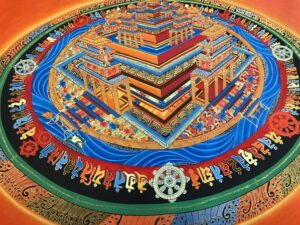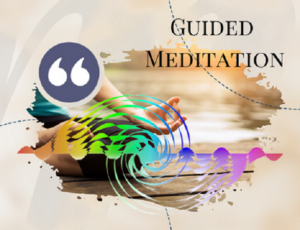How to Meditate for Beginners
A lot of people ask about how to begin meditation. This tutorial is for you who are approaching meditation for the first time.
There is a lot to know about meditation. There’s a philosophy of the disappearing ‘I’ or ego. There are detailed systems such as Patanjali’s Ashtangha Yoga with a goal of Samadhi. There are a host of benefits and challenges, various traditions and styles. This tutorial will not cover any of that. The purpose here is only to show you one approach to begin your journey into Self.
- Location: First, find your place. Your space. Many meditators look for a ‘perfect place’. That is not necessary yet. As you begin to really enjoy meditation, you will begin to find your ‘perfect places’. For now, any place outside or inside that you feel comfortable sitting in for about 30 minutes to an hour will do. This can be your bedroom, living room, garden, a park, the beach, etc.
PRO TIP: Let that place be one where you will not be disturbed for the duration of your meditation. If the AC or heater is on, make sure it’s not blowing directly on you!
- Disturbances: Turn off the electronics. If you’re inside the house, turn off your mobile phone, unplug your house phone, make sure the video deck is not on and humming. Don’t be near the ice-maker or the ticking clock. If the neighbor’s dog is barking, try to pick a time you know that dog is sleeping. If possible, you want to limit the disturbances as much as possible. The first few times in meditation, you want to enjoy an easy ride.
PRO TIP: Actually, you DON’T NEED TO CARE about disturbances if you let nothing disturb you and are able to maintain a focus on your breath.
- Tools:
- Music: Soft music, played in the background or nearby – air instruments like flute or lute are ideal. No headphones, only softly in the background. No vocals. You don’t want your focus on the music, or the lyrics, yet. Let the music be of a length of time equal to your planned meditation length. Music only serves to aid relaxation at this early stage in your journey.
PRO TIP: The change-ups in the instrumentals (space between songs), and the length of the tracks can serve as time-markers for you when you start wondering about how long you’ve been sitting there!
- Incense: Only soft scents, nothing overpowering. A lot of people on the path of well-being like to use sage to cleanse their space. Sage can be an overwhelming smell the first time around, particularly if it gets very smoky. Choose a scent you are used to and one that you personally enjoy. I like sandalwood, but some brands are too sweet for my tastes and some sticks or cones create too much smoke which makes my breathing uncomfortable and my nostrils itch. Place your incense where the smoke is not going to interfere with your meditation, just close enough to enjoy the scent.
PRO TIP: Chinese ‘joss sticks’ come in gentle fragrances that don’t smoke overly much!
- Clothes: Loose and comfortable. Track suits, underclothes, pajamas – all good. You don’t want to restrict blood flow, cause excessive warmth (or cold) or provide any distraction to your body. Think of how you like to feel when you go to sleep for the night.
PRO TIP: When the temperature allows and if you are comfortable with your own body, and you are in your own private space, no clothes at all is a valid option!
- Candles: For the meditation that I will introduce below, a single candle may be used. It is not absolutely necessary, but the single flame provides a nice focus as you begin to enter into your meditation. Have a table, box or other to stand the candle in front of you.
PRO TIP: A slow burning candle with a wax consistency that lets it melt into patterns down the side of the candle and around the base can be a fantastic focus point, too!
- Cushions: If you choose a posture of sitting on the floor, or on your bed, with your legs crossed, the a single cushion placed at the base of your spine just under the coccyx will prop up your back a few inches (10-20cm) and allow you to sit comfortably with a straight posture for longer periods.
PRO TIP: Sit on your bed and use your sleeping pillow. It’s easy, available, a good size and you already know that you love it. Plus, it allows you to be ready for a good sleep after!
- Posture: Sitting is recommended although laying down is also an option. If you are laying down, lay on your back, if possible with palms facing up. If you sleep, don’t worry. Enjoy your sleep. If sitting, you may sit as is most comfortable for you, cross-legged on the floor, or feet on the floor in a chair. If cross-legged on the floor, keep your legs simply crossed, don’t attempt lotus position or anything complicated for your joints. It is not necessary. The cushion will let you keep upright. If sitting in a chair, let your back and shoulders rest against the back of the chair.
PRO TIP: Don’t care too much about how perfect your posture is. The point here is to stay upright, comfortable and enjoy the meditation.
- Breath: For the purpose of this meditation we will be using a patterned breathing technique which I will explain more below. The pattern will follow an inhalation-exhalation-hold routine for a certain count beginning with 4-count IN, 6-count OUT, c-count HOLD.
PRO TIP: In through the nose, out through the mouth is standard practice, but for people with nose issues, mouth breathing is fine. And as you go deeper into relaxation, simply using the nose is also perfect.
So let’s begin!
You’ve chosen your space. You are dressed and sitting comfortably. There are few or no disturbances. Incense is lit. Music is playing softly in the background. Cushion is under your bum. Candle is lit and about 2 feet in front of you.
- Allow your gaze to rest on the flickering candle flame. Enjoy the dancing, the glow. Notice the melting wax pooling around the bottom of the wick, perhaps beginning to descend along the side. Just enjoy it for a couple of minutes.
- Begin to gently breathe. Inhale for a slow 4-count. Exhale for a slow 6-count. At the bottom of the arc, hold gently for 2 beats and begin the inhale count again. One round of this cycle means about 12 seconds meaning 5 rounds will be about a minute. This means you are taking 5 breaths per minute. That’s quite slow. And if it is too slow for you, of course you may begin with 2-4-1 count until your body has relaxed enough to go slower. (You are still enjoying the candle while you breathe.)
- After 5-10 minutes of 4-6-2 pattern your body will have gotten used to the routine. There is no need to count how many rounds you have completed. Only the pattern of INHALE 4, EXHALE 6 HOLD GENTLY at the arc.
NOTE: The hold is not a lock. It is not an intentional hold. It is only the place where the exhalation has stopped. A gentle resting point. There is no pressure, no intentional stopping of the breath. Just a rest before moving back to the inhalation.
- When you are ready, when the 4-6-2 pattern has become very easy, you may proceed to a pattern of 6-8-2. Then 8-10-2. Then 10-12-4. Now you are taking about 2 breaths a minute. At this point, you have probably felt the desire to close your eyes.
- Eyes are closed. Breathing is relaxed and rhythmical. Stay focused on the breath. You may reduce the length of the breathing pattern back to normal relaxed breathing now. But stay focused on your own rhythm. Don’t count. Just feel yourself inhale. Notice the arc. Feel your diaphragm moving gently with the breath. By this stage, you have probably been sitting for 20-30 minutes.
- Now the question is, what you are wanting to accomplish through meditation. You are ready to do many things at this point. You may raise energy. You may explore your body with your inner eye. You may raise consciousness and attention. At this moment, you are exercising your focus while oxygenating your body, providing health to your mind and body while relaxing the stress. You are setting the stage for further development.
- During your meditation – because you are actually meditating now – you will see many thoughts flash in your mind. Try to avoid staying with any particular thought. You may avoid focusing on a particular thought by bringing your focus back to your breath, back to the count. You may refocus on the candle flame, either by opening your eyes, or by visioning it with your inner eye. You may acknowledge the thoughts simply by saying ‘Not this thought. Not this thought.’ The purpose of that is to bring the mind into a little stillness. When the mind reaches a very still and silent place – THAT is a very interesting opportunity for SELF to manifest and things get, well, let’s say things get interesting!
- During your meditation you may feel physical feelings like heat, joint aches, maybe even the pattern of breath making you dizzy or other discomfort. STOP! You do not need to care about not doing your meditation ‘correctly’. If something is uncomfortable, you STOP. Get yourself comfortable. The point here is to get still, get quiet, get silent, get comfortable, get relaxed, enjoy. If your legs don’t like to be crossed for a long time, you may have to uncross them. If the breath pattern is too long or too short, you may have to adjust.
- Notice your feelings during the meditation. Physical feelings, emotions. Notice your thoughts. Notice your visions. When you come out of the experience, have a journal nearby to note down your experiences. This will be a valuable record for you to monitor your experience and development. When you come out of your meditation, take a few minutes to have some water or some tea, stay in your own space for a few minutes more and reflect on what your experience was. Note it down along with the date, time, tools, results, etc.
- You have just completed your first beginning-level meditation. The path of Self-exploration, development and knowledge is deep and vast. Perhaps you want to look into some of the traditions, or perhaps you have a goal in mind already. I invite you to discuss with me further and pick my brain. I’ve been at this for a long time and I’ve picked the brains of some good masters before me, too!
This is a very basic routine. A primer. There are many other ways to approach the art of meditation for the first time. I invite you to ask questions and share feedback of your experience in the comments section below.
With Love & Blessings upon Blessings
Dev

…is a Saiva Tantrika, Gyana Yogi and founder of Uma Maheshwara Yoga & Ayurveda. David has an MA in Semiotics, lives in Japan with his family and works as a coach in L & D, devoting his time to developing science-based tools and programs that help people reach the fullest potential of the human condition.
Discover more from REAL YOGA
Subscribe to get the latest posts sent to your email.









